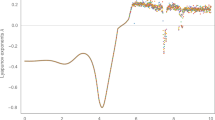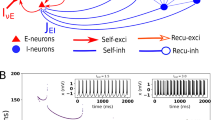Abstract
Out-of-phase bursting is a functionally important behavior displayed by central pattern generators and other neural circuits. Understanding this complex activity requires the knowledge of the interplay between the intrinsic cell properties and the properties of synaptic coupling between the cells. Here we describe a simple method that allows us to investigate the existence and stability of anti-phase bursting solutions in a network of two spiking neurons, each possessing a T-type calcium current and coupled by reciprocal inhibition. We derive a one-dimensional map which fully characterizes the genesis and regulation of anti-phase bursting arising from the interaction of the T-current properties with the properties of synaptic inhibition. This map is the burst length return map formed as the composition of two distinct one-dimensional maps that are each regulated by a different set of model parameters. Although each map is constructed using the properties of a single isolated model neuron, the composition of the two maps accurately captures the behavior of the full network. We analyze the parameter sensitivity of these maps to determine the influence of both the intrinsic cell properties and the synaptic properties on the burst length, and to find the conditions under which multistability of several bursting solutions is achieved. Although the derivation of the map relies on a number of simplifying assumptions, we discuss how the principle features of this dimensional reduction method could be extended to more realistic model networks.
Similar content being viewed by others
References
Bartos, M., Manor, Y., Nadim, F., Marder, E., & Nusbaum, M. P. (1999). Coordination of fast and slow rhythmic neuronal circuits. Journal of Neuroscience, 19, 6650–6660.
Bertram, R., & Sherman, A. (2000). Dynamical complexity and temporal plasticity in pancreatic beta-cells. Journal of Biosciences, 25, 197–209.
Bose, A., Manor, Y., & Nadim, F. (2001). Bistable oscillations arising from synaptic depression. SIAM Journal on Applied Mathematics, 62, 706–727.
Butera, R. J. (1998). Multirhythmic bursting. Chaos, 8, 274–284.
Canavier, C. C., Baxter, D. A., Clark, J. W., & Byrne, J. H. (1994). Multiple modes of activity in a model neuron suggest a novel mechanism for the effects of neuromodulators. Journal of Neurophysiology, 72, 872–882.
Canavier, C. C., Clark, J. W., & Byrne, J. H. (1991). Simulation of the bursting activity of neuron R15 in Aplysia: Role of ionic currents, calcium balance, and modulatory transmitters. Journal of Neurophysiology, 66, 2107–2124.
Chay, T. R., & Rinzel, J. (1985). Bursting, beating, and chaos in an excitable membrane model. Biophysical Journal, 47, 357–366.
Coombes, C., & Bressloff, P. (Eds.) (2005). Bursting: The genesis of rhythm in the nervous system. London: World Scientific.
Destexhe, A., & Sejnowski, T. J. (2003). Interactions between membrane conductances underlying thalamocortical slow-wave oscillations. Physiological Reviews, 83, 1401–1453.
Ermentrout, G. B., & Kopell, N. (1998). Fine structure of neural spiking and synchronization in the presence of conduction delays. In Proceedings of the National Academy of Sciences of the United States of America, 95, 1259–1264.
Grillner, S., Markram, H., De Schutter, E., Silberberg, G., & LeBeau, F. E. (2005). Microcircuits in action—from CPGs to neocortex. Trends in Neurosciences, 28, 525–33.
Hines, M., Morse, T., Carnevale, N., & Shepard, G. (2004). Model DB: A database to support computational neuroscience. Journal of Computational Neuroscience, 17, 7–11.
Huguenard, J. R. (1996). Low-threshold calcium currents in central nervous system neurons. Annual Review of Physiology, 58, 329–48.
Huguenard, J. R., & McCormick, D. A. (1992). Simulation of the currents involved in rhythmic oscillations in thalamic relay neurons. Journal of Neurophysiology, 68, 1373–1383.
Izhikevich, E. M., & Hoppensteadt, F. C. (2004). Classification of bursting mappings. International Journal of Bifurcation and Chaos, 14, 3847–3854.
Keener, J., & Sneyd, J. (1998). Mathematical physiology (pp. 154–155). New York: Springer-Verlag.
Lechner, H. A., Baxter, D. A., Clark, J. W., & Byrne, J. H. (1996). Bistability and its regulation by serotonin in the endogenously bursting neuron R15 in Aplysia. Journal of Neurophysiology, 75, 957–962.
Lee, E., & Terman, D. (1999). Uniqueness and stability of periodic bursting solutions. Journal of Difference Equations, 158, 48–78.
Lofaro, T., & Kopell, N. (1999). Timing regulation in a network reduced from voltage-gated equations to a one-dimensional map. Journal of Mathematical Biology, 38, 479–533.
Llinas, R. R., & Steriade, M. (2006). Bursting of thalamic neurons and states of vigilance. Journal of Neurophysiology, 95, 3297–3308.
Manor, Y., & Nadim, F. (2001). Synaptic depression mediates bistability in neuronal networks with recurrent inhibitory connectivity. Journal of Neuroscience, 21, 9460–9470.
Marder, E., & Calabrese, R. (1996). Principles of rhythmic motor pattern generation. Physiological Reviews, 76, 687–717.
Masino, M. A., & Calabrese, R. L. (2002). Period differences between segmental oscillators produce intersegmental phase differences in the leech heartbeat timing network. Journal of Neurophysiology, 87, 1603–1615.
Medvedev, G. (2005). Reduction of a model of an excitable cell to a one-dimensional map. Physica D, 202, 37–59.
Morris, C., & Lecar, H. (1981). Voltage oscillations in the barnacle giant muscle fiber. Biophysical Journal, 35, 193–213.
Perkel, D. H., & Mulloney, B. (1974). Motor pattern production in reciprocally inhibitory neurons exhibiting postinhibitory rebound. Science, 185, 181–183.
Rubin, J., & Terman, D. (2000). Geometric analysis of population rhythms in synaptically coupled neuronal networks. Neural Computation, 12, 597–645.
Satterlie, R. (1985). Reciprocal inhibition and postinhibitory rebound produce reverberation in a locomotor pattern generator. Science, 229, 402–404.
Selverston, A., & Moulins, M. (1986). The Crustacean stomatogastric system : A model for the study of central nervous systems. Berlin Heidelberg New York: Springer.
Skinner, F. K., Kopell, N., & Marder, E. (1994). Mechanisms for oscillation and frequency control in reciprocally inhibitory model neural networks. Journal of Computational Neuroscience, 1, 69–87.
Sohal, V., & Huguenard, J. (2001). It takes T to tango. Neuron, 31, 35–45.
Terman, D. (1994). Chaotic spikes arising from a model of bursting in excitable membranes. SIAM Journal on Applied Mathematics, 51, 1418–1450.
Terman, D., Kopell, N., & Bose, A. (1998). Dynamics of two mutually coupled slow inhibitory neurons. Physica D, 117, 241–275.
Traub, R. D., Whittington, M. A., Colling, S. B., Buzsaki, G., & Jefferys, J. G. (1996). Analysis of gamma rhythms in the rat hippocampus in vitro and in vivo. Journal of Physiology, 493, 471–484.
Van Vreeswijk, C., Abbott, L. F., & Ermentrout, B. (1994). When inhibition not excitation synchronizes neural firing. Journal of Computational Neuroscience, 1, 313–321.
Wang, X. J., & Buzsaki, G. (1996). Gamma oscillation by synaptic inhibition in a hippocampal interneuronal network model. Journal of Neuroscience, 16, 6402–6413
Wang, X. J., & Rinzel, J. (1992). Alternating and synchronous rhythms in reciprocally inhibitory model neurons. Neural Computation, 4, 84–97.
Wang, X. J., & Rinzel, J. (1994). Spindle rhythmicity in the reticularis thalami nucleus: Synchronization among mutually inhibitory neurons. Neuroscience, 53, 899–904.
Author information
Authors and Affiliations
Corresponding author
Additional information
Action Editor: John Rinzel
Rights and permissions
About this article
Cite this article
Matveev, V., Bose, A. & Nadim, F. Capturing the bursting dynamics of a two-cell inhibitory network using a one-dimensional map. J Comput Neurosci 23, 169–187 (2007). https://doi.org/10.1007/s10827-007-0026-x
Received:
Revised:
Accepted:
Published:
Issue Date:
DOI: https://doi.org/10.1007/s10827-007-0026-x




